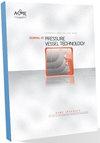低应力下316H不锈钢等时应力-应变曲线的非保守性
IF 1.4
4区 工程技术
Q4 ENGINEERING, MECHANICAL
Journal of Pressure Vessel Technology-Transactions of the Asme
Pub Date : 2022-05-19
DOI:10.1115/1.4054622
引用次数: 0
摘要
未来的第四代高温反应堆预计将在450摄氏度以上运行,其中蠕变效应在安全相关结构(如反应堆容器)中非常显著。ASME BPVC第三节第5部分提供了此类高温部件的设计规则和方法。与设计者相关的是规范中变形极限规则的等时应力-应变曲线(ISSCs)。ISSCs是一种重要的方法,用于估计在高温下给定应力和持续时间下累积的非弹性应变。在本研究中,通过采用物理知情的最小蠕变速率模型重新构建当前版本的ASME BPVC第三节第5部分中316H钢的ISSC,在593-750C之间对其进行了重新评估。研究表明,与低应力(例如650C、40MPa)下的实验数据相比,当前的ASME第三节第5部分最小蠕变速率模型对蠕变速率的预测不足。通过采用基于物理的最小蠕变速率模型来捕捉扩散和位错滑移/爬升控制的蠕变状态,解决了这一缺陷。然后采用该修正的最小蠕变速率模型对316H不锈钢的ASME ISSC进行了重构。研究发现,ASME ISSC可以将在约S/Sy为0.65的情况下持续1000小时的总累积应变低估10倍,这可能导致非弹性应变的非保守性。不同温度下的实验数据证实了这一发现。讨论了解决这种非保守主义的潜在方法。本文章由计算机程序翻译,如有差异,请以英文原文为准。
Non-Conservatism of ASME BPVC Section III Division 5 Isochronous Stress-Strain Curves for 316H Stainless Steel at Low Stresses
Future Gen IV high-temperature reactors are expected to operate above 450C where creep effects are significant in safety-related structures, e.g., reactor vessels. ASME BPVC Section III Division 5 provides the rules and methodologies for design of such high-temperature components. Of relevance to the Designer are the isochronous stress-strain curves (ISSCs) part of the rules for deformation limits in the Code. The ISSCs are an important method to estimate accumulated inelastic strains at a given stress and duration at elevated temperatures. In this study, the ISSCs for 316H steel in the current edition of ASME BPVC Section III Division 5 have been re-evaluated between 593-750C by adopting a physics-informed minimum creep rate model to re-construct them. It is demonstrated that the current ASME Section III Division 5 minimum creep rate model underpredicts creep rates compared to experimental data at low stresses (e.g., 650C, 40 MPa). By employing a physics-informed minimum creep rate model capturing both diffusive- and dislocation glide/climb-controlled creep regimes, this deficiency is addressed. The ASME ISSCs for 316H stainless steel are then reconstructed by adopting this modified minimum creep rate model. It was found that the ASME ISSCs could underestimate total accumulated strains at ~S/Sy of 0.65 for durations of 1,000 hr by 10 times which could give rise to non-conservatism in inelastic strain. Experimental data at various temperatures confirm the findings. Potential approaches to address this non-conservatism are discussed.
求助全文
通过发布文献求助,成功后即可免费获取论文全文。
去求助
来源期刊
CiteScore
2.10
自引率
10.00%
发文量
77
审稿时长
4.2 months
期刊介绍:
The Journal of Pressure Vessel Technology is the premier publication for the highest-quality research and interpretive reports on the design, analysis, materials, fabrication, construction, inspection, operation, and failure prevention of pressure vessels, piping, pipelines, power and heating boilers, heat exchangers, reaction vessels, pumps, valves, and other pressure and temperature-bearing components, as well as the nondestructive evaluation of critical components in mechanical engineering applications. Not only does the Journal cover all topics dealing with the design and analysis of pressure vessels, piping, and components, but it also contains discussions of their related codes and standards.
Applicable pressure technology areas of interest include: Dynamic and seismic analysis; Equipment qualification; Fabrication; Welding processes and integrity; Operation of vessels and piping; Fatigue and fracture prediction; Finite and boundary element methods; Fluid-structure interaction; High pressure engineering; Elevated temperature analysis and design; Inelastic analysis; Life extension; Lifeline earthquake engineering; PVP materials and their property databases; NDE; safety and reliability; Verification and qualification of software.

 求助内容:
求助内容: 应助结果提醒方式:
应助结果提醒方式:


